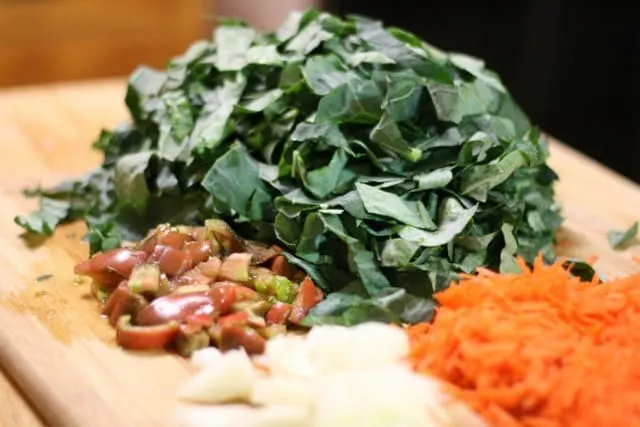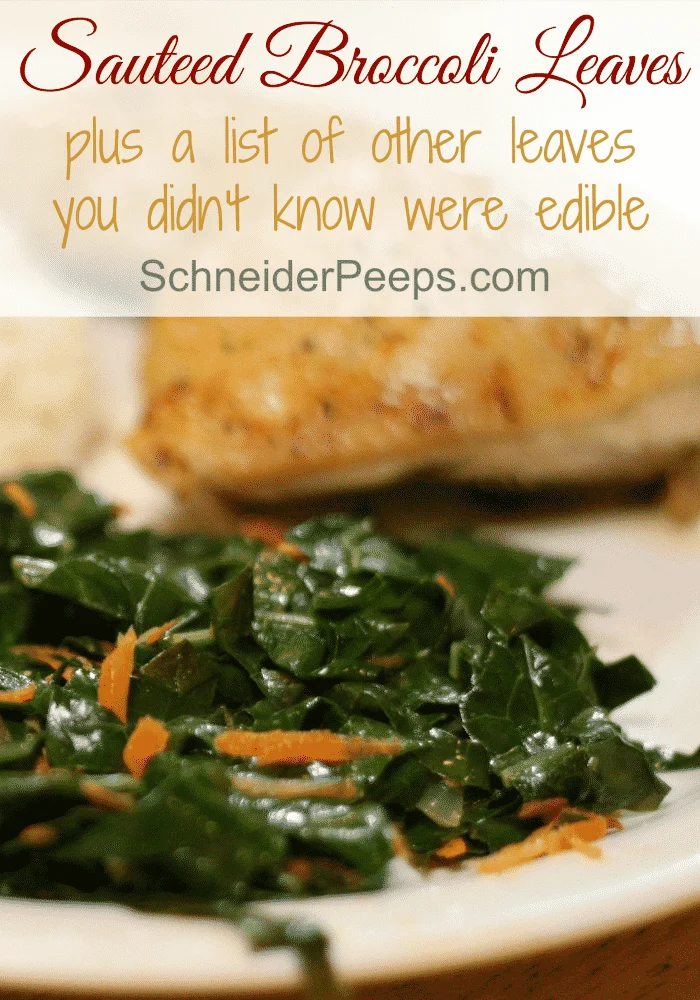
Can you eat cauliflower leaves? Are broccoli leaves edible? These are questions I found myself asking a friend. I knew you *could* eat a cauliflower leaf but did it really taste good? I’m sure I’m not the only one who wonders these things.
Whenever my friend from Kenya comes over she reminds me of how many vegetables I have in my garden. I see broccoli, cauliflower and cabbage that isn’t big enough to harvest and eat. But she sees a garden full of vegetables that can be eaten that day.
I’ve been trying to follow her lead and cook some of the leaves while the heads continue to grow. You can’t harvest all the leaves or you’ll stunt the plant’s growth but you can certainly harvest some.
There are quite a lot of plants that have edible leaves in addition to the primary part we normally eat, the leaves are called the secondary edible part. Plants that have edible leaves include, snap beans, lima beans, carrots, cauliflower, broccoli, beets, brussel sprouts, cucumbers, okra, kohlrabi, peas, sweet potatoes, radish, and squash. However, not all plants have edible leaves, for instance tomatoes, peppers and potatoes have toxic leaves so if you’re unsure double check.
I’ve created a handy printout for you to keep in your gardening notebook or in your kitchen that lists the plants with edible leaves. Just fill in the form below and it will be emailed to you.
How to cook broccoli and cauliflower leaves

I harvest about one large leaf per person. They don’t cook down as much as spinach so you won’t need to harvest as much. We like to use olive oil and add onion, grated carrots and tomatoes to the pan. And then saute for about 3-5 minutes. It doesn’t take long.
Some leaves will taste different than their primary harvested part and some will taste similar to it. Also, different varieties of the same plant can taste different. So, if you cook some leaves and it’s not to your liking, try a different one. Also, the flavor will change a bit the longer you cook them.
Consider these “free” food, so play around with them to figure out which ones your family likes and how they like them. Eating secondary plants parts is just one way I keep a low waste kitchen.
To help you get started on using secondary edible parts, I’ve included a few recipes and tips below.
Growing Sweet Potato Leaves Indoors
Broccoli and Cheddar Hushpuppies

Do you eat the secondary parts of plants? Share your tips in the comments. (If you get this post via email you’ll need to click over to leave your comment.)

Harold Burton
Monday 21st of June 2021
I’m always looking for lighter chicken recipes. This looks like a good one to try!
Harold Burton
Karien
Tuesday 6th of October 2020
Good day, kindly forward me the list of edible vegetable leaves. Thank you
Angi Schneider
Saturday 10th of October 2020
Karien, I've added your email to the sign up box in the post. You will get an email with a link to our subscriber library which has the edible vegetable leaves print out. You can unsubscribe at any time.
Jo
Wednesday 4th of March 2020
Is cooking califlower leaves like broccolini. I love greens, and brokolini I saute with olive oil and chopped garlic.
Angi Schneider
Thursday 5th of March 2020
Hi Jo, the texture of cooked cauliflower leaves and broccoli leaves is similar to kale but tastes like cauliflower and broccoli.
Cathy mills
Wednesday 21st of August 2019
I planted broccoli for the first time. The stalk and leaves have grown but there is no broccoli head as yet. Just thinking of eating the leaves so as it's not a complete waste of time. Why is my broccoli not growing as it should
Angi Schneider
Friday 23rd of August 2019
Well, that's a bummer! There are several reasons why it might not be producing a head. It could be that the variety you planted takes a long time to produce. Most varieties need 55-70 days but some need more. The days are counted from when they get their first true leaves, not when the seed is planted. If you started with transplants, start counting from when you put them in the ground, just know that it takes them a few days to get acclimated before they start growing again. It might be that it's too hot and the plants haven't reached full size yet? Broccoli is a cool weather plant and needs to be planted in the very early spring for an early summer harvest. If you planted later and the plants are healthy, I would leave them in the ground through fall and see if they eventually produce. In the meantime, the leaves are very tasty, so enjoy them. If you grow a fall garden, try growing an early variety. Broccoli is frost tolerant so it will be able to withstand light frosts and the frosts will even improve the flavor. Hope this helps!
Cynthia Recupero
Sunday 28th of July 2019
I’m so happy to have found this article! I’ve had a long time interest in nutrition and totally missed this information. Thank you! I am beginning hydroponic gardening and will be eating my leaves...
Angi Schneider
Sunday 28th of July 2019
That's great, Cynthia. You'll be amazing at how eating the secondary harvest of plants can really stretch the harvest. Good luck with the hydroponics, I've heard great things about it.